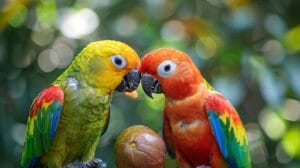Why This Cheat Sheet Exists
Midjourney is an incredible tool, but if you’ve ever spent hours tweaking a prompt to get the right image, you know how frustrating it can be.
The goal of this cheat sheet is simple: cut through the noise and provide exactly what you need to make Midjourney work for you.
Let’s break it all down, from essential commands to advanced techniques.
What Is Midjourney?
Midjourney is an AI-powered image-generation tool that turns text prompts into visuals. Unlike traditional design software, it works entirely through Discord.
You type a description, and Midjourney creates an image based on what it thinks you want.
Mastering how you phrase your prompts and adjust parameters is the key to getting results that match your vision.
Midjourney Features
Midjourney comes packed with several powerful features. Understanding how they work will help you make the most of the tool.
🟩 Text-to-image generation. Type in a prompt, and Midjourney creates an image based on your description.
🟩 Style control. Modify the artistic look of your images using different parameters.
🟩 Aspect ratio customization. Adjust the dimensions of your images to suit different formats.
🟩 Chaos and variation. Add randomness or keep things precise depending on your needs.
🟩 Upscaling and refinement. Increase resolution and sharpen details in your images.
🟩 Multi-prompt support. Blend multiple elements into a single image using structured inputs.
Commands & Parameters
Getting started with Midjourney means learning the basic commands. Below are the key ones you’ll use daily.
List of commands
Everything in Midjourney happens via commands in Discord. Here are some essentials:
- /imagine – Generates an image based on your text.
- /info – Displays your subscription status and usage.
- /settings – This lets you adjust model versions, quality, and more.
- /blend – Merges two images into a new composition.
- --test and --testp – Experimental models with different aesthetics.
Aspect ratios
By default, Midjourney generates 1-to-1 square images. If you need a different format, use the --aspect / --ar parameter:
- --ar 2:3 : Portrait – Best for posters and social media stories.
- --ar 4:5 : Standard print – Common for traditional art compositions.
- --ar 16:9 : Landscape – Great for YouTube thumbnails & banners.
Quality settings
Midjourney also allows you to control the level of detail in your images with the --q parameter:
- --q 1 : Default – Balanced speed and quality.
- --q 2 : Higher quality – More detail, slightly slower.
- --q 5 : Max quality – Highest detail, longest processing time.
Don’t fight the chaos. Sometimes, randomness creates magic.
Chaos level
The --chaos parameter determines how much randomness is in the results:
- --chaos 0 : Predictable and controlled results.
- --chaos 50 : Moderate experimentation.
- --chaos 100 : Wild, unpredictable compositions.
Crafting Prompts
Writing good prompts is the secret to getting great images. The AI takes what you write very literally, so clarity is crucial.
Clear descriptive language
Stock photo of orange tabby cat that demonstrates “photorealistic.”
Instead of writing “a cat,” go for something like “a photorealistic orange tabby cat lounging on a vintage armchair, soft lighting, 4K”. The more detail, the better.
Visual references
You can provide URLs of images as references. This helps Midjourney understand the style or mood you want to replicate.
Advanced Prompt Techniques
Once comfortable with basic prompts, you can explore advanced techniques for greater control.
Permutation prompts
Permutation prompts let you generate multiple variations in one go using {}:
This prompt would generate three separate images:
- A red car
- One blue car
- And another green car
Multi prompts with word weight
You can assign different levels of importance to elements in your prompt using :: –
This tells Midjourney to focus mostly on the futuristic city while keeping neon lights as a minor detail.
Brand Identity
If you’re using Midjourney for business, consistency matters. Here’s how to make AI-generated artwork for your brand.
Tips for consistent branding
- Use the same style prompts repeatedly to create a unified aesthetic.
- Stick with the same aspect ratios and quality settings.
- Build a reference library of your preferred styles and images.
Audience Engagement
AI-generated art can become a powerful tool for audience engagement. People love to see the creative process unfold, and sharing your Midjourney workflow can spark conversations, build trust, and even create a community around your work.
Showcase your creativity
One way to engage your audience is by sharing raw vs. refined versions of your images.
Showcasing the different stages of AI-generated art (initial results, adjustments, and final edits) can help your audience appreciate the effort behind the final product.
This also invites feedback and discussion, allowing your followers to be part of the creative journey.
Audience participation
Letting your audience vote on different image variations is another way to boost engagement.
Whether you’re designing a product, creating concept art, or experimenting with styles, polls, and votes can involve your community in the decision-making process.
This increases engagement and makes your followers feel invested in your work.
Storytelling with AI art
AI-generated images can be more than static visuals. They can also serve as storytelling tools.
Use your images to create narratives, illustrate blog posts, or even develop characters for fictional projects.
Share the story behind each piece and invite your audience to interpret or expand upon it, turning passive viewers into active participants.
User-generated content
Another great strategy is to encourage your followers to experiment with Midjourney themselves.
Share your prompts, offer tips, and invite them to create their own AI-generated artwork.
Highlighting audience submissions and engaging with their creations fosters a sense of community and keeps the conversation going.
By integrating these engagement strategies, you can make AI-generated art a dynamic and interactive part of your brand or creative identity.
Cheat Codes & Quick Reference Sheets
Midjourney has several built-in shortcuts that can make your workflow faster and more efficient.
These cheat codes allow you to fine-tune your images without manually adjusting every detail.
Whether you’re aiming for a specific art style, removing unwanted elements, or ensuring consistency, these commands will help.
Cheat codes overview
- --hd : Generates high-definition images with more intricate details.
- --v 5 : Uses version 5 of the model for improved quality.
- --tile : Creates seamless, repeating patterns, great for wallpapers and textures.
- --uplight : A lighter upscaling option that preserves fine details without over-sharpening.
- --no [element] : Excludes unwanted objects, such as --no text.
- --seed [number] : Generates consistent results using a fixed starting point.
- --stylize [value] : Adjusts the level of artistic style applied.
For example, use --stylize 1000 for more abstraction.
Using these cheat codes allows for greater control over how Midjourney interprets and renders your prompts. Experiment with different values to see what works best for your creative needs.
Quick reference materials
Keep a personal list of go-to prompts, aspect ratios, and settings that work best for your needs. Save it somewhere easy to access.
Advanced Functionalities
Midjourney becomes even more powerful when used alongside other tools. Whether you need post-processing, workflow automation, or integration with other AI models, these strategies can help.
Integrating Midjourney with other tools
Refining AI-generated images often requires additional editing.
Tools like Photoshop or Canva help clean up artifacts, add text, or enhance color grading. If you need more flexibility, pairing Midjourney with DALL·E allows for greater creative freedom.
Workflow automation is another way to save time. Platforms like Zapier and Notion help organize prompts, archive generated images and streamline your creative process.
Workflow efficiency
Speeding up your process means finding ways to generate and store images effectively. Batch processing prompts allow for rapid experimentation without manually re-entering commands.
Discord bots can help with archiving your best results, making it easier to track past creations. AI up-scaling tools can significantly improve output quality for those needing high-resolution images.
Troubleshooting Common Issues
Even the best AI tools can run into issues.
If you’re experiencing problems with Midjourney, here’s how to troubleshoot the most common ones.
Unresponsive bots
“This is Fine” Meme
Sometimes, Midjourney may not respond to your commands. Here’s what to check:
- Verify server status. Visit Midjourney’s official Discord or status page to see if there are ongoing outages.
- Check your subscription. If your plan has expired, you won’t be able to generate new images.
- Restart Discord. A simple restart can fix minor glitches.
- Re-enter the command. If the bot didn’t recognize your request, try again with a slightly modified prompt.
- Use a different channel. Some Midjourney Discord channels may be more responsive than others.
Fixing Quality Problems
If your images are turning out blurry or low-quality, consider these solutions:
- Increase quality settings. Use the --q 2 or --q 5 parameter for higher resolution images.
- Use the upscale feature. Midjourney allows you to refine and enhance generated images by upscaling them.
- Be more descriptive. Vague prompts can lead to unclear results. Add more specific details to guide the AI.
- Try different versions. If you’re using an older model, try --v 5 or the latest Midjourney version.
- Reduce chaos. If your images look too random, lower the --chaos setting to get more controlled results.
You can make the most out of Midjourney by troubleshooting these common issues and avoiding unnecessary frustration.
Your brand’s visual identity starts with consistent prompts and parameters.
Real World Applications
Midjourney is more than just a novelty. Many professionals are already using it effectively.
Professional use cases
- Marketing: Create eye-catching visuals for social media.
- E-commerce: Generate product mockups and concept art.
- Publishing: Illustrate blog posts, book covers, and editorial content.
- Architecture: Visualize interior and exterior designs.
Creative project examples
- Concept art for video games.
- AI-generated children’s book illustrations.
- Experimental album covers and digital posters.
Support Resources
Midjourney has an active community filled with users who share tips, discuss techniques, and help each other refine their AI-generated images. Being part of this community can speed up your learning process and inspire new creative directions.
Joining the community
One of the best ways to learn is by engaging with other users. Join the official Midjourney Discord to participate in discussions, get prompt inspiration, and see how others approach image creation.
Reddit and Threads also have thriving AI art communities where users share their best prompts and results.
Tutorials and feedback
There’s no shortage of resources to help you improve. Midjourney’s official guides provide detailed explanations of settings and features.
YouTube tutorials offer step-by-step walkthroughs to refine your skills.
If you’re looking for constructive criticism, the Midjourney communities are a great place to get feedback from experienced users.
Final Thoughts
By leveraging these resources, you’ll better understand Midjourney and improve your ability to generate high-quality images.
AI-generated art isn’t here to replace human creativity but to expand it. Start experimenting, refine your prompts, and share your work. If you found this useful, subscribe to stay ahead of the AI art game.




